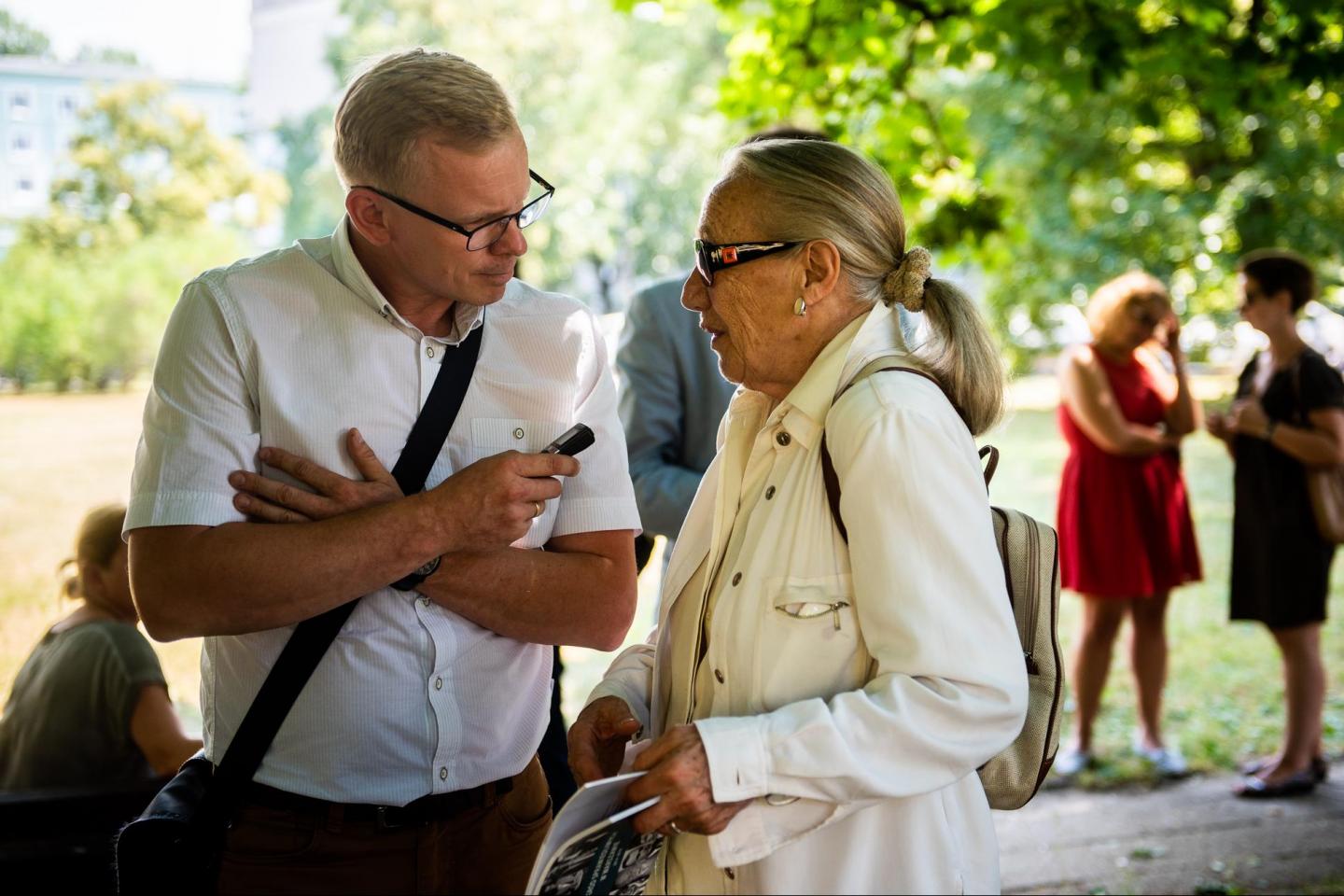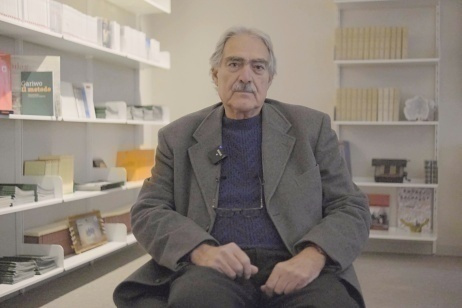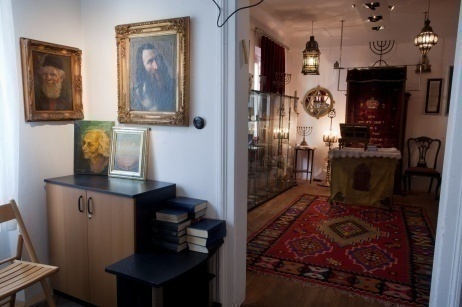Anna Ziarkowska is a Polish historian, political scientist, and writer. She is the secretary of the Committee for the Garden of the Righteous of Warsaw and the head of education at History Meeting House, a cultural institution in Warsaw that focuses on the history of Central and Eastern Europe in the 20th century. Since 2014, the History Meeting House takes care of the Garden of the Righteous Worldwide in Warsaw, the first one in Poland. In this interview, Anna Ziarkowska tells us about the Garden, its history, symbolic location, activities, and relationship with the Jewish community. Warsaw's Garden embraces a universal celebration of the Righteous, having turned Polish history into a lens to look at the world and connect with unfamiliar others.
Let us start with the history of this Garden: when did the project start, and how did it come alive?
It all started in 2008, when, together with Gabriele Nissim and Antonia Grasselli, we organized an international conference on the definition of “Righteous”. It was the first step towards the creation of a Garden: on that occasion, we started discussing the concept of Righteous not only in relation to the notion of “Righteous among the Nations” – a title referring to non-Jewish individuals who saved Jews during the Shoah – but also in a global, universal perspective, in relation to other genocides in history. After the conference, we discussed the idea of developing a Garden of the Righteous Worldwide in Poland with Gariwo, and we started searching for a partner. Thanks to the encounter with the former Prime Minister of Poland and the founder of Solidarność Tadeusz Mazowiecki, we eventually finalized the project. To the express wish of Mazowiecki, a Committee for the Garden of the Righteous of Warsaw was established during the celebrations of the first European Day of the Righteous on March 6, 2013 [a day that was set up upon Gariwo’s proposal, thanks to the synergy between the Italian and Polish Members of Parliament, who later involved the entire European Parliament]. After Mazowiecki’s appeal, a local mayor in Warsaw offered us a piece of land to set up the Garden, which we inaugurated in 2014.
What drove you in the choice of the right location for Warsaw’s Garden?
We chose this place out of two or three proposals because this location was highly symbolic in terms of memorial heritage. The Garden is located in the former territory of the Warsaw ghetto and next to Pawiak prison, which the Gestapo used as a prison in WWII, by imprisoning, torturing, and killing thousands of resistance fighters and political prisoners during the occupation of Warsaw. The Garden is also two steps away from the Church of St Augustine, another highly symbolic place because of the many priests there who used to help the Jews during the war. Some of them were even killed for this reason. The Church of St Augustine became iconic in the aftermath of the war because it was the only thing left in a stretch of ruins, almost a glimmer of hope left for the city. Finally, the Garden is not far from the Polin Museum of the History of Polish Jews, so visitors who go there can stop by the Garden and visit. Each time we plan a new tree today, we still happen to dig up some remains of the ghetto. One of the strengths of Warsaw’s Garden of the Righteous Worldwide is that it is symbolically located in a place that was the quintessence of the Nazi occupation.
What do you do in the Garden? What are your main activities?
We do many things. First of all, every year on March 6, we celebrate the European Day of the Righteous with concerts and debates. The most important part of our work, however, is education. We have a special program for kids and children of all ages; we organize workshops for students and teachers; we publish a series of books on the theme of the Righteous. This year, for example, we will publish a graphic novel entitled Mazowiecki, which focuses on the figure of Tadeusz Mazowiecki and will be presented on the anniversary of the Communist regime’s collapse. The graphic novel was made in collaboration with Rafał Bujnowski, a well-known Polish artist, and by some students of Polish academies of fine arts. During the pandemic, we even created a virtual play for smartphones through a Norwegian platform called Action Truck that allows people – children with their families, or even teachers – to visit the Garden virtually, having access to many photographic materials and educational activities. Finally, in the academic year 2021-2022, we started a project with the Warsaw University of Technology to modernize the Garden. We divided the students into six groups during one semester to work on a project to renovate the Garden, eventually choosing two of them. This idea stemmed from a new partnership we established with the French bank BNP Paribas. BNP Paribas is very active on environmental issues, a value that we share very much. We think it is essential to keep the Garden alive even in this department.
What makes your educational programs different? What methodologies do you use?
The preparation of the teachers and educators is absolutely crucial to our mission. Our staff is very well prepared. This is not because we fill teachers with data and statistics. Instead, we seek to develop an empathic and personal approach to memory and history, which we think is lacking in schools. In this light, I would speak about behavior rather than methodology. In this rationale, we work a lot with oral history archives, and we make considerable use of individual biographies. Individual stories are powerful tools to make history alive in the eyes of students. When students can hear the voices and see the faces of people and families, history touches them directly.
In Warsaw’s Garden, you only honour figures that are dead. What is the reason for this choice?
It’s something we discussed at the very beginning of the project. We all believed that it is only at the end of a biography that you can really assess whether a person deserves a title like that of “Righteous”. To some extent, it is a way to be sure about the figures we choose.
How does the Garden’s involvement with Solidarność influence your activity? Do people perceive this connection as controversial in any way?
In some ways, yes. That portion of Polish history is very recent. There’s little distance from those events, and so it is difficult to make a sharp distinction between history and politics. Political conflicts or controversies may arise, for example, when we happen to announce new figures of Righteous that were linked to Solidarność. Yet, many years have passed, things are changing, and the Committee members are getting more courageous in their choices. This year, for example, we decided to honour Karol Modzelewski, one of the founders of Solidarność, who dedicated his life to fighting for democracy in Poland. We’ll see how the press and the public will react. In general, Poland is a very polarized country. With regards to Solidarność, you will always have people for and against you.
What does it mean to have a Garden of the Righteous Worldwide in Poland, a country that experienced the two totalitarian regimes of the 20th century, Nazism and Communism?
In my view, the experience of both totalitarianisms made Poland a more empathic and receptive country to the injustices suffered by different people in different cultural and historical contexts. If you think about that, our history is what makes this Garden the right place to celebrate the notion of “Righteous” in a universal perspective, with an eye to other genocides and mass exterminations. In Warsaw’s Garden, only 25% of our Righteous are Righteous Among the Nations, while 75% represent other genocides. There is a fair proportion between the Polish and the global experience: our idea is not to focus only on ourselves, on a self-referential narrative of Polish victimhood, but to connect, through our experience, to unfamiliar others who went through similar events. At the same time, our Garden is deeply rooted at a local level. It is crucial for us to connect with the community and neighborhood around us, to cooperate with people, and make sure the Garden is perceived as a collective good. I think we were successful in this endeavour: we never witnessed any vandalization. We are always willing to listen to the needs of the people around us.
What about the Jewish community in Warsaw? How do they see your openness towards other genocides and the extension of the notion of Righteous to non-Jewish contexts?
We are on very good terms with the Jewish community in Warsaw: they are very open to the universalization of the Righteous notion and to the idea that the Righteous might exist even in non-Jewish contexts. In general, the Jewish community is central to our efforts. We could not have achieved what we did without their support. Members of the Jewish community sit in our Committee and are of great help to diffuse our activities and make them known to the world.
Like other Western countries, Poland is now facing growing nationalism and intolerance towards minorities. In 2018, a controversial Holocaust law passed, with angered many Holocaust survivors. Does all this affect the Garden in some way?
Not really, actually. The exemplary figures we honour in our Garden are like crystal, and it is very difficult to question their value. Here is where the value of our Committee lies: each time, there is a lot of discussion in the choice of the Righteous. We seek to adopt a future-looking perspective, which helps us disentangle our work from day-to-day ideological exploitations.
Do you think a Polish Day of the Righteous will ever exist?
Yes, that is definitively possible. In two months, the Warsaw mayor will start the ball rolling with a round table on this issue with our Committee. Step by step, we will go in that direction.
Do you think that other Gardens of the Righteous Worldwide will be created across Poland?
Yes, I think that could happen. Perhaps, the first place to create another Garden might be Auschwitz itself.


.jpg)
.jpg)
.jpg)
.jpg)
.jpg)
.jpg)
.jpg)
.jpg)
.jpg)
.jpg)
.jpg)
.jpg)
.jpg)
.jpg)
.jpg)
.jpg)
.jpg)
.jpg)
.jpg)
.jpg)
.jpg)
.jpg)
.jpg)
.jpg)
.jpg)
.jpg)
.jpg)
.jpg)
.jpg)
.jpg)
.jpg)
.jpg)
.jpg)
.jpg)
.jpg)

.jpg)
.jpg)
.jpg)
.jpg)
.jpg)
.jpg)
.jpg)
.jpg)
.jpg)
.jpg)
.jpg)



